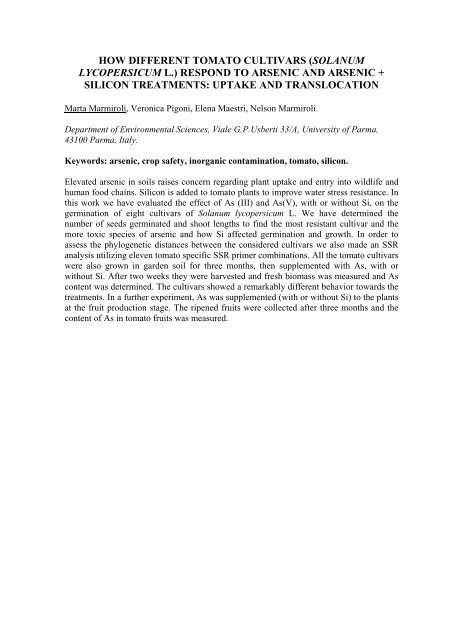Book with abstracts from the COST Action 0905 meeting in ... - UMB
Book with abstracts from the COST Action 0905 meeting in ... - UMB
Book with abstracts from the COST Action 0905 meeting in ... - UMB
Create successful ePaper yourself
Turn your PDF publications into a flip-book with our unique Google optimized e-Paper software.
HOW DIFFERENT TOMATO CULTIVARS (SOLANUM<br />
LYCOPERSICUM L.) RESPOND TO ARSENIC AND ARSENIC +<br />
SILICON TREATMENTS: UPTAKE AND TRANSLOCATION<br />
Marta Marmiroli, Veronica Pigoni, Elena Maestri, Nelson Marmiroli.<br />
Department of Environmental Sciences, Viale G.P.Usberti 33/A, University of Parma,<br />
43100 Parma, Italy.<br />
Keywords: arsenic, crop safety, <strong>in</strong>organic contam<strong>in</strong>ation, tomato, silicon.<br />
Elevated arsenic <strong>in</strong> soils raises concern regard<strong>in</strong>g plant uptake and entry <strong>in</strong>to wildlife and<br />
human food cha<strong>in</strong>s. Silicon is added to tomato plants to improve water stress resistance. In<br />
this work we have evaluated <strong>the</strong> effect of As (III) and As(V), <strong>with</strong> or <strong>with</strong>out Si, on <strong>the</strong><br />
germ<strong>in</strong>ation of eight cultivars of Solanum lycopersicum L. We have determ<strong>in</strong>ed <strong>the</strong><br />
number of seeds germ<strong>in</strong>ated and shoot lengths to f<strong>in</strong>d <strong>the</strong> most resistant cultivar and <strong>the</strong><br />
more toxic species of arsenic and how Si affected germ<strong>in</strong>ation and growth. In order to<br />
assess <strong>the</strong> phylogenetic distances between <strong>the</strong> considered cultivars we also made an SSR<br />
analysis utiliz<strong>in</strong>g eleven tomato specific SSR primer comb<strong>in</strong>ations. All <strong>the</strong> tomato cultivars<br />
were also grown <strong>in</strong> garden soil for three months, <strong>the</strong>n supplemented <strong>with</strong> As, <strong>with</strong> or<br />
<strong>with</strong>out Si. After two weeks <strong>the</strong>y were harvested and fresh biomass was measured and As<br />
content was determ<strong>in</strong>ed. The cultivars showed a remarkably different behavior towards <strong>the</strong><br />
treatments. In a fur<strong>the</strong>r experiment, As was supplemented (<strong>with</strong> or <strong>with</strong>out Si) to <strong>the</strong> plants<br />
at <strong>the</strong> fruit production stage. The ripened fruits were collected after three months and <strong>the</strong><br />
content of As <strong>in</strong> tomato fruits was measured.
















